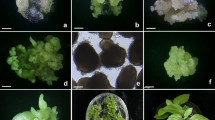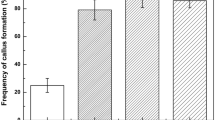Summary
Inflorencence stalks from greenhouse-grownGladiolus plants of the cultivars ‘Blue Isle’ and ‘Hunting Song’ cultured on a Murashige and Skoog basal salts medium supplemented with 53.6 μM 1-napthaleneacetic acid formed a compact, not friable type of callus that regenerated plantlets. Cormel slices and intact plantlets of three cultivars (‘Peter Pears’, ‘Rosa Supreme’, ‘Jenny Lee’) propagated through tissue culture formed a friable type of callus when cultured on Murashige and Skoog basal salts medium supplemented with 2,4-dichlorophenoxyacetic acid. This friable callus readily formed a cell suspension when the callus was placed in a liquid medium. Plants were regenerated from two-month-old suspension cell cultures of the commercial cultivar ‘Peter Pears’ after the suspension cells had been cultured on solid medium.
Similar content being viewed by others
References
Ammirato, P. V. Somatic embryogenesis and plantlet development in suspension cultures of the medicinal yam,Dioscorea floribunda. Am. J. Bot. 65:89; 1978.
Artunduaga, I. R.; Taliaferro, C. M.; Johnson, b. L. Effects of auxin concentration on induction and growth of embryogenic callus from young inflorescence explants of old world bluestem (Bothriochloa spp.) and bermuda (Cynodon spp.) grasses. Plant Cell Tissue and Organ Culture 12:13–19; 1988.
Brettell, R. I. S.; Wernicke, W.; Thomas, E. Embryogenesis from cultured immature inflorescences ofSorghum bicolor. Protoplasma 104:141–148; 1980.
Chu, C. C.; Wang, C. C.; Sun, C. S., et al. Establishment of an efficient medium for anther culture of rice through comparative experiments on the nitrogen sources. Scientia Sin. 18:659–668; 1975.
Dalton, S. J. Plant regeneration from cell suspension protoplasts ofFestuca arundinacea Schreb (tall fescue) andLolium perenne L. (perennial ryegrass). J. Plant Physiol. 312:170–175; 1988.
Gosch-Wackerle, G.; Avivi, L.; Galun, E. Induction, culture and differentiation of callus from immature rachises, seeds and embryos ofTriticum. Z. Pflanzenphysiol. 91:267–278; 1979.
Harris, R.; Wright, M.; Byrne, M., et al. Callus formation and plantlet regeneration from protoplasts derived from suspension cultures of wheat (Triticum aestivum L.). Plant Cell Rep. 7:337–340; 1988.
Heyser J. W. Callus and shoot regeneration from protoplasts of proso millet (Panicum miliaceum L.). Z. Pflanzenphysiol. 113:293–294; 1984.
Horn, M. E.; Conger, B. V.; Harms, C. T. Plant regeneration from protoplasts of embryogenic suspension culture of orchardgrass (Dactylis glomerata L.) Plant Cell Rep. 7:371–374; 1988.
Hosoki, T.; Asahira, T.In vitro propagation ofNarcissus. HortSci. 15:602–603; 1980.
Hussey, G.In vitro propagation ofGladiolus by precocious axillary shoot formation. Sci. Hort. 6:287–296; 1977.
Krikorian, A. D.; Kann, R. P. Plantlet production from morphogenetically competent cell suspensions of daylily. Ann. Bot. 47:679–686; 1981.
Ling, D. H.; Chen, W. Y.; Chen, M. F., et al. Direct development of plantlets from immature panicles of ricein vitro. Plant Cell Rep. 2:172–174; 1983.
Logan, A. E.; Zettler, F. W. Rapidin vitro propagation of virus-indexedGladioli. Acta Horticulturae 164:169–180; 1985.
Lu, C.; Vasil, I. K. Somatic embryogenesis and plant regeneration from freely-suspended cells and cell groups ofPanicum maximum. Ann. Bot. 48:543–548; 1981.
Lu, C. Y.; Vasil, V.; Vasil, I. K. Isolation and culture of protoplasts ofPanicum maximum Jacq. (Guinea grass): Somatic embryogenesis and plantlet formation. Z. Pflanzenphysiol. 104:311–318; 1981.
Murashige, T.; Skoog, F. A revised medium for rapid growth and bio assays with tobacco tissue cultures. Physiol. Plant. 15:473–497; 1962.
Novak, F. J.; Afza, R.; VanDuren, M., et al. Somatic embryogenesis and plant regeneration in suspension cultures of dessert (AA and AAA) and cooking (ABB) bananas (Musa spp.). Biotech. 7:154–159; 1989.
Ozias-Akins, P.; Vasil, I. K.. Plant regeneration from cultured immature embryos and inflorescences ofTriticum aestivum L (wheat): evidence for somatic embryogenesis. Protoplasma 110:95–105; 1982.
Prioli, L. M.; Söndahl, M. R. Plant regeneration and recovery of fertile plants from protoplasts of maize (Zea mays L.) Biotech. 7:589–594; 1989.
Rhodes, C. A.; Lowe, K. S.; Ruby, K. L. Plant regeneration from protoplasts isolated from embryonic maize cell cultures. Biotech. 6:56–61; 1988.
Shilito, R. D.; Carswell, G. K.; Johnson, C. M., et al. Regeneration of fertile plants from protoplasts of elite inbred maize. Biotech. 7:581–587; 1989.
Shimamoto, K.; Terada, R.; Izawa, T. et al. Fertile transgenic rice plants regenerated from transformed protoplasts. Nature 338:274–276; 1989.
Simonsen, J.; Hindebrandt, A. C.In vitro growth and differentiation ofGladiolus plants from tissue culture. Can. J. Bot. 49:1817–1819; 1971.
Srinivasan, C.; Vasil, I. K. Plant regeneration from protoplasts of sugarcane (Saccharum officinarum L.) J. Plant Physiol. 126:41–49; 1986.
Toriyama, K.; Arimoto, Y.; Uchimiya, H., et al. Transgenic rice plants after direct gene transfer into protoplasts. Biotech. 6:1072–1074; 1988.
Vasil, V.; Vasil, I. K. Isolation and culture of cereal protoplasts Part 2: embryogenesis and plantlet formation from protoplasts ofPennisetum americanum.Theor. Appl. Genet. 56:97–99: 1980.
Vasil, V.; Vasil, I. K. Characterization of an embryogenic cell suspension culture derived from cultured inflorescences ofPennisetum americanum. Amer. J. Bot. 69:1441–1450; 1982.
Vasil, I. K.; Vasil, V.; Lu, C. et al. Variability in plants regenerated from tissue culture. In: Earle, E. D.; Demarly, Y., eds. Somatic embryogenesis in cereals and grasses. New York, NY: Praeger Publishers; 1982:3–21.
Vasil, V.; Wang, D.-Y.; Vasil, I. K. Plant regeneration from protoplasts of napier grass (Pennisetum purpureum Schum.). Z. Pflanzenphysiol. 111:233–239; 1983.
Wilfret, G. J.. Shoot-tip culture ofGladiolus: an evaluation of nutrient media for callus tissue development. Florida State Horticultural Society 84:389–393; 1971.
Wright, N. A.; Alderon, P. G.; Rice, R. D. Towards the clonal propagation of Tulip by tissue culture. In: Fujiwara, A., ed. Proc. 5th Intl. Congress Plant Tissue and Cell Culture. Plant Tissue Culture. Tokyo, Japan: Abe Photo Printing: 1982:697–698.
Ziv, M.; Halevy, A. H.; Shilo, R. Organs and plantlets regeneration ofGladiolus through tissue culture. Ann. Bot. 34:671–676; 1970.
Author information
Authors and Affiliations
Rights and permissions
About this article
Cite this article
Kamo, K., Chen, J. & Lawson, R. The establishment of cell suspension cultures ofGladiolus that regenerate plants. In Vitro Cell Dev Biol 26, 425–430 (1990). https://doi.org/10.1007/BF02623835
Received:
Accepted:
Issue Date:
DOI: https://doi.org/10.1007/BF02623835




